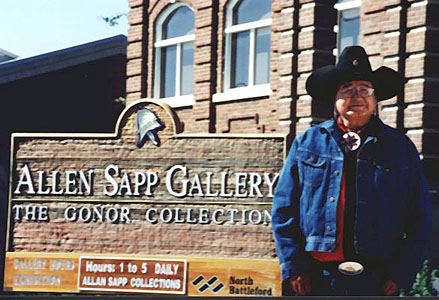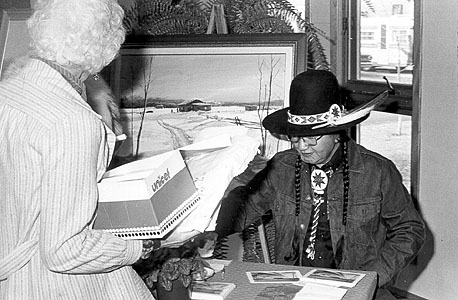|
 |
||||||||
Re-printed with permission from the Allen Sapp Gallery: The Gonor Collection which is open to the public. Allen Sapp was born in
the winter of 1928 on the Red Pheasant Reserve in north
central Saskatchewan. He was a weak and sickly child born
to a mother who herself had to fight for her life and who
eventually died of tuberculosis. Allen was raised and
cared for by Maggie Soonias, his grandmother. The memory
of this tender relationship has spawned in Sapp some of
his finest and most sensitive works, bringing to his
canvas a sense of affection and love rarely communicated
or seen in the twentieth century art world.
In September of
1968, Wynona invited Allen to show his paintings on the
grounds of her home in Saskatoon. In spite of the
weather, the show was a great success, but this favorable
response from a largely artistically cultured crowd in no
way prepared them for the overwhelming public response to
his first major exhibition only seven months later. It
was Easter weekend at the Mendel Art Gallery in
Saskatoon; a show of sixty-one oils and acrylics had been
assembled and hung. When the doors finally opened that
weekend some 13,000 viewers passed through the gallery.
At the conclusion of opening night most of the sixty-one
paintings had been sold. That Easter weekend in 1969
began an explosion of interest and fascination with
Sapp's work that resulted in shows from London, England
through to most major cities in Canada and cities in the
United States including New York and Los Angeles. Allen
Sapp had come of age. Reviews on his shows came from all
quarters. He was applauded by the public as a 20th
century painter they could relate to and by the critics
as a painter whose style created "illusionism so
arresting as to constitute a revelation". (Daily
Telegraph of London, 1969). By now Allen himself had
begun to grasp the full implications of his success, but
his reaction was modest and in character. He had found in
painting his memories and his people a sense of pride in
who he was and where he had come from and so began his
own journey in becoming the Cree Indian he had discovered
within. Allen had begun to discard his white man's
appearance. He let his hair grow into long braids that he
tied up with deerskin. He began to wear denim cowboy
boots, beaded medallions and a headband along with his
cowboy hat. He was a descendant of the great Chief
Poundmaker and had begun to understand the pride of being
able to live that. It was during that period that Allen
observed simply "better to be a good Indian then a
poor white man." So Allen became that "good
Indian", but fate also held that he was to become an
Indian of central importance to the preservation and
renaissance of his own culture. In May of 1976, Allen
visited New York to attend the opening of h s show at the
Hammer Galleries. Diana Loercher of the Christian Science
Monitor observed of Sapp and his work, "He had great
reverence for the land, a tradition in Indian Religion,
and derives much of his inspiration from nature. A
radiant light permeates most of his paintings.... It is
evident that not only his art but his identity is deeply
rooted in Indian culture." It was this deeply-rooted
identity that acted to stabilize Allen during these years
of great attention and ensured his values and priorities
remained true. As Doctor Gonor observed: ''His values
have not changed. Because of the traditional Indian
belief in sharing, he uses his car as a taxi and cares
more about participating in religious ceremonies and
dances then painting. Even though he cannot keep up with
the demand." The significance of Sapp's return to
his roots and the stability and vision it offered him
cannot be understated. But aside from Sapp's own heritage
the other important influence and stabilizing factor in
his life was the deep and wonderful friendship that grew
between himself and Doctor Allan Gonor.
In December 1985, Allen Sapp was elected to the Royal Canadian Academy of Arts (R.C.A.A.). Election to the R.C.A.A. means something far beyond commercial success for an artist. The historic role pursued by the R.C.A.A. through the years has been to maintain the highest standards in the cultivation of the fine and applied arts in Canada. Members of the R.C.A.A. represent a cross-section of Canada's most distinguished artists. Election to membership is the acknowledgment of the quality and value of Sapp's work by one of the most demanding and discriminating groups concerned with the arts in Canada, his own peers. As each new award or acknowledgment came, Allen's reaction remained modest and simple. In 1980 he met Princess Margaret and presented her with one of his paintings. In 1981, a book A Cree Life The: Art of Allen Sapp was released and found its way across Canada as a very popular bestseller. These and many other events all helped to maintain the focus on Sapp's contribution as an artist. 1985 was the year that began a subtle but important change in what was to be the way his contribution as an artist was viewed. It was this same year he was to face the news that his good friend and patron, Doctor Allan Goner, had died while visiting in Thailand. Allen Sapp, from a very early age, had come to know and experience the death of others as an inevitable part of life. He, himself, had experienced the death of many members of his own family and had struggled deeply with the loss of loved ones. It was his determination and strength of character that seemed to guide Allen through these difficult times. This strength of character made Allen not only a good and valued artist but a person of exceptional value to his whole community. It was that aspect of Allen's contribution which began to emerge and the community that was to call him their own began to expand far beyond the bounds of the Red Pheasant Reserve or the City of North Battleford. On December 5, 1985, Allen Sapp became one of the first eight recipients of the Saskatchewan Award of Merit. This award is given in recognition of individual excellence and/or contributions to the social and economic well-being of the province and its residents. It was one of the first indications that Allen Sapp's contributions, not only as an artist but as an individual, were being felt. There was a building awareness that somehow Sapp's contributions were not just limited to exceptional art. He had become recognized as a significant force in the renaissance of the Indian culture. His art clearly had the ability to cross cultural barriers and, not only acted as a beacon for aspiring native artists, but also as a vehicle for other cultures to comprehend the Indian way of life. It came as no surprise that in 1986, at the "New Beginnings" Native Art Show in Toronto, Allen Sapp was singled out as one of the Senior Native Artists in Canada, "whose contributions to the present renaissance of native art and culture will only be measured by history." That simple observation seemed almost prophetic in light of what was about to occur. In January 1987, the Governor General of Canada appointed Allen Sapp an Officer to the Order of Canada as a means of recognizing outstanding achievements and honoring those who have given service to Canada, to their fellow citizens or to humanity at large. After more than half a century, the prophetic words spoken by the Nootokao, who had placed her hand upon his forehead as Allen lay sick, had now come to pass. "'There was a purpose for this frail one, who made such a determined effort to live.... He had made the Naheyow proud of him and had become a blessing to both the Naheyow and the white race." The opening of the Allen Sapp Gallery: The Gonor Collection is truly but another page in what has become one of the most fascinating stories in Canadian Art History. The importance of the gallery as a signpost for aspiring artists and as a vehicle in the promotion and conservation of our Canadian heritage cannot be overstated. But possibly the most important role this gallery will play through the art of Allen Sapp is to provide a bridge for healing and quiet dialogue between white and native cultures thereby creating a deep understanding and respect not otherwise possible. National Aboriginal Achievement Awards Reprinted
with permission from
Grandmother believed in boy's artistic talent By Joan Black Reprinted
with permission from Some things about Allen Sapp you should know. He has stayed true to his vision, all his life it seems like, becoming materially successful on his own terms. The other things you should know is that he is proud to be an Indian and he is proud of what he has accomplished as an artist, but he never fell into the trap of producing knock-off "Native art" to make a buck. In fact, he used to be criticized sometimes for not painting the stereotypical Norval Morrisseau derivatives that gallery hoppers buy from some other Indians as "the real stuff." Today, Sapp's portrayal of rural life on the Red Pheasant Indian Reserve in the Saskatchewan of the first half of this century has come into its own. You know when you view one of Sapp's pictures you are seeng a slice of his reality and not a copy of somebody else's. It's the real Plains Cree life of days gone by, which Sapp is painstakingly recording so people don't forget. Sapp's culture and heritage are set down in every brush stroke. All you have to do is look. Many have, and many have recognized the same talent that Sapp's grandmother, Maggie Soonias, believed in and encouraged more than 60 years ago. His art is and has been exhibited and sold in galleries around the world, recently in the trendy Yorkville Avenue district of Toronto. There is also a permanent collection of his works in a gallery baring his name in North Battleford, Sask., where he lives. A retrospective of his work toured Canadian cities for two years before closing at the Canadian Museum of Civilization in 1996. Many honors have come to Sapp as a result of his lengthy artistic career. In 1975, for instance, Sapp was elected to membership in the Royal Canadian Academy of Arts, which recognized his "outstanding achievements in the visual arts field." Diane Rosenthal, director of the Hollander York Gallery in Toronto, prices Sapp's paintings into the thousand of dollars now. She describes them as "focused, celebrating a family-centred time . . . an optimistic look at his life as a child on the reserve - nostalgic and . . . a little bit impressionistic." Rosenthal reinforces that Sapp's art is grounded in the daily life of his people in the 1930s and 1940s, when they still lived without modern conveniences; it does not reflect the mythological themes of a lot of Native art. It is the nature of the business that there have always been some critics, though. "Sometime people say I have painted too many winter scenes," Sapp explains; "but nobody says the Group of Seven painted too many landscapes." Sapp still enjoys doing what he does and that seems to be enough for most people. But there is more to Allen Sapp than his paintings. Aboriginal people are proud that he maintains his strong cultural ties and provides a positive, progressive array of Indian values their youth can carry into the next century. He speaks his Cree language and he is proud to be a traditional dancer, too, Sapp will tell you. In 1985, Sapp became one of the first recipients of the Saskatchewan Order of Merit; in 1987 he was named Officer of the Order of Canada; and in 1996 the Saskatchewan Arts Board gave him the Lifetime Award for Excellence in the Arts. Last spring, the University of Regina bestowed on Sapp an honorary doctorate. Along the way, three books reproducing his art, and a number of film documentaries have brought Sapp's perspective on life to the world. On March 12, the Aboriginal people of Canada recognized Sapp's great legacy and contribution, by selecting him for the National Aboriginal Achievement Award for Lifetime Achievement. Sapp's manager, John Kurtz, related how Sapp enjoys sharing his good fortune with others. He has donated his time and his art to worthy causes, and he cares a lot about helping children, Kurtz said. That means passing on stories in the traditional Cree way. Sapp urges children to learn all they can about their culture, so it will provide them strength throughout life. And, Sapp adds earnestly, he tells them to get an education, to "listen to their parents and teachers -- to learn English and Cree."
Links: (click on X in top right corner of outside link to return to photo gallery) Well-Known Indian Artist Elected to R.C.A.A. Allen Sapp Aboriginal Achievement Awards - 1999 Award Recipients Fine Arts student wins President's Medal "Went to get some water", Allan Sapp "Working in the Field", Allan Sapp |
|||||||||









 Dr. Sapp is from the Red
Pheasant First Nation in Saskatchewan. His paintings are
famous across the world and is considered to be among the
best in the world of Aboriginal painters. Sapp's
commercial success began when he sold some of his
paintings to North Battleford's Dr. Allen Goner. In 1989
the Allen Sapp Gallery-Goner Collection opened in his
honour and he has been the subject of numerous
documentaries and profiles. He has stayed involved with
the youth, taking time to warn them of the dangers of
drugs and alcohol. He has been a champion of the Native
Heritage Founadation.
Dr. Sapp is from the Red
Pheasant First Nation in Saskatchewan. His paintings are
famous across the world and is considered to be among the
best in the world of Aboriginal painters. Sapp's
commercial success began when he sold some of his
paintings to North Battleford's Dr. Allen Goner. In 1989
the Allen Sapp Gallery-Goner Collection opened in his
honour and he has been the subject of numerous
documentaries and profiles. He has stayed involved with
the youth, taking time to warn them of the dangers of
drugs and alcohol. He has been a champion of the Native
Heritage Founadation.